Almost finished up my 30 hertz TH today...have to glue 2 more panels and she's good to go.
Pictures???!!!
More info please. What driver and so forth?
Johannes.
Didn't ave my camera yesterday, but I have it with me today and will get a few shots of it before it's all glued up. Making it in 2 pieces so I can take it home in my car.
The driver is an Image Dynamics IDQ12 v2 with dual 2 ohm coils. Specs are really similar to the Peerless driver that William Cowan used...so I thought I would try it out, that and I already have it in a sealed box in the system.
The driver is an Image Dynamics IDQ12 v2 with dual 2 ohm coils. Specs are really similar to the Peerless driver that William Cowan used...so I thought I would try it out, that and I already have it in a sealed box in the system.
Yeah, if the published specs are ~accurate it should actually be a better 'fit' in that it will be less under-damped.
What an interesting difference over sealed...so MUCH more efficient. Seems to be going lower, more impact and definition.
More poor Slimlines can't hang...might be time to build some new midbass horns or K-coupler for some 12s or 15s.
Need to play with positioning- ie a long the wall, firing up, and towards you. Right now she's exactly where the old sealed sub was at.
Thank god I have a good girl, she didn't blink an eye when I showed up with a 6' tall MDF column.
More poor Slimlines can't hang...might be time to build some new midbass horns or K-coupler for some 12s or 15s.
Need to play with positioning- ie a long the wall, firing up, and towards you. Right now she's exactly where the old sealed sub was at.
Thank god I have a good girl, she didn't blink an eye when I showed up with a 6' tall MDF column.
hornresp 17.00 is available. Didn´t have time so far to take a look at it. Did anyone take a peek so far?
Within the last days I tried to optimize the response of the two possible drivers I have. The Next CL15 car sub did not work out as good as the Eminence which behaves like that:
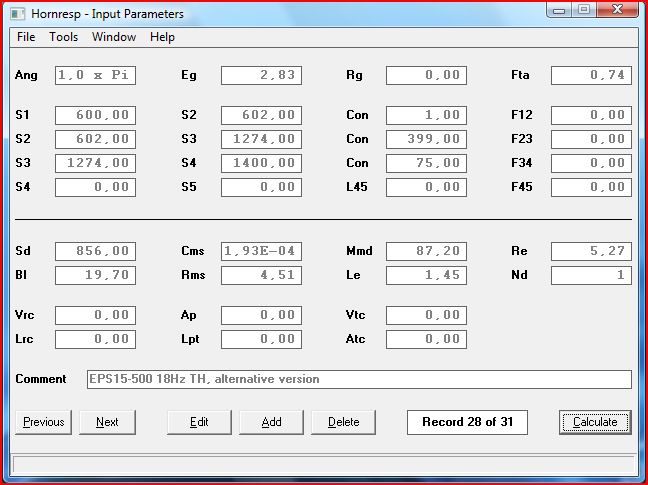
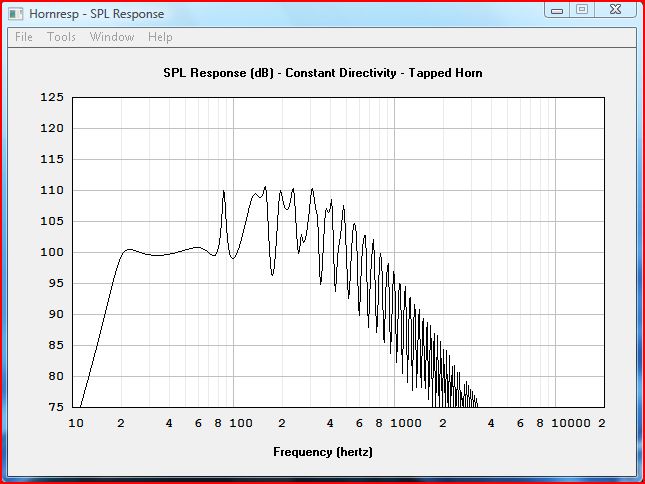
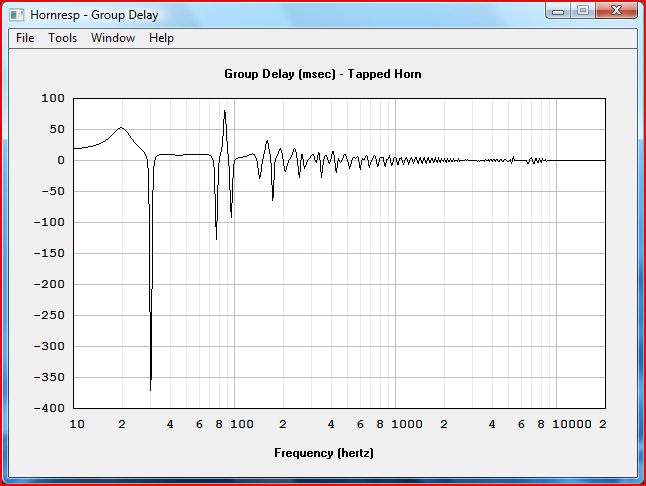
Even though this TH will be quite large (approx. 450l gros volume when built from 22mm MD) I will give it a try.
On the weekend I will think about the way of folding them into a box (note the large offset of the driver to the mouth of the horn). Actually this is causing some headace.
Even though this TH will be quite large (approx. 450l gros volume when built from 22mm MD) I will give it a try.
On the weekend I will think about the way of folding them into a box (note the large offset of the driver to the mouth of the horn). Actually this is causing some headace.
Due to room gain, you're going to see at least a 6-12db peak at 20hz.
Aren't you worried that it's going to sound sluggish?
Aren't you worried that it's going to sound sluggish?
Your first segment only is 1cm long, which is very hard to build since the driver already is 38cm wide, 19cm radius. How are you planing to get around this?
The room the TH will be installed in is 4.5x10x2.55m (WxLxH).
Ho can one predict the amount and frequency of room gain? Actually I did not take this into acoount.
I better should, should'nt I?
Regarding S1 it may depend on the style of folding. Sorry for my bad sketch, but this is what I thought of so far:
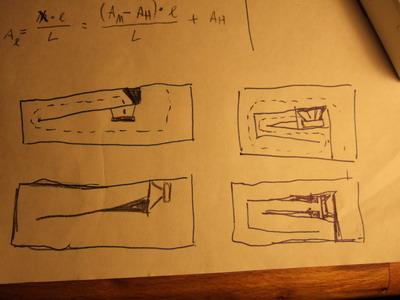
Ho can one predict the amount and frequency of room gain? Actually I did not take this into acoount.
I better should, should'nt I?
Regarding S1 it may depend on the style of folding. Sorry for my bad sketch, but this is what I thought of so far:

Volvotreter said:The room the TH will be installed in is 4.5x10x2.55m (WxLxH).
Ho can one predict the amount and frequency of room gain? Actually I did not take this into acoount.
I better should, should'nt I?
Yes, I've seen programs that will predict room gain.
It's a huge deal - in a small room it can lead to 12db peaks in the low bass!
Predictions can be flawed due to leaks, absorbtion by drywall, etc...
Easiest way to measure your "room gain" is to just get a sub, measure it in an open field outside, then put the same sub in your room and re-measure it.
The difference between the two measurements is equivalent to that room's gain.
This method isn't perfect, it doesn't account for the boundary outside, but it's close enough.
Abakad is able to calculate the room influence, if I´m not mistaken. LSPCad also is able to do it, although you´d have to export the SPL Curve from Hornresp and feed it into Abakad or LSPCad
It should be possible to EQ the room-gain out easily - for the benefit of higher SPL and/or lower distortion.
Regards
Charles
Regards
Charles
OK, the first version of my TH is done (design wise) and looks like the following:
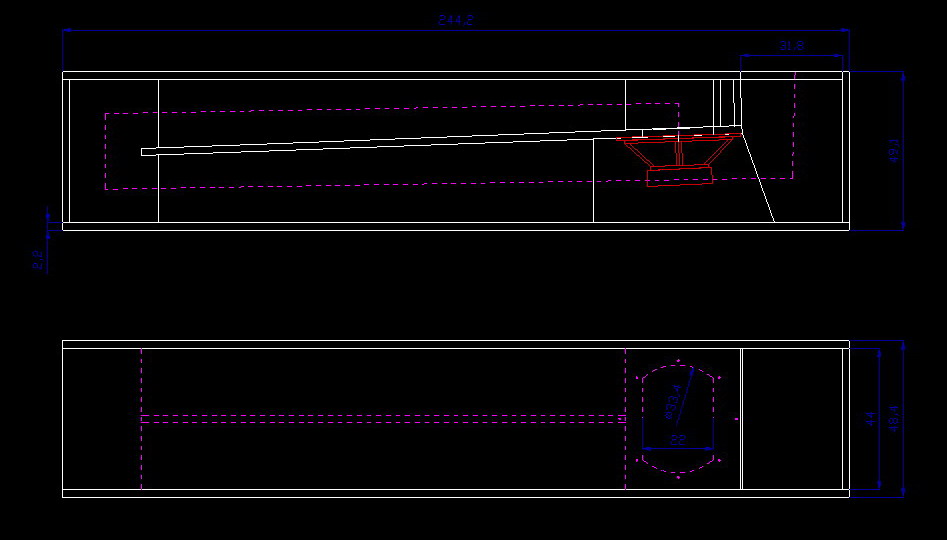
Due to the folding I had to reduce the overall length a little bit. With the original path length it would not vertically fit into my room.
The following parameters result fom that:
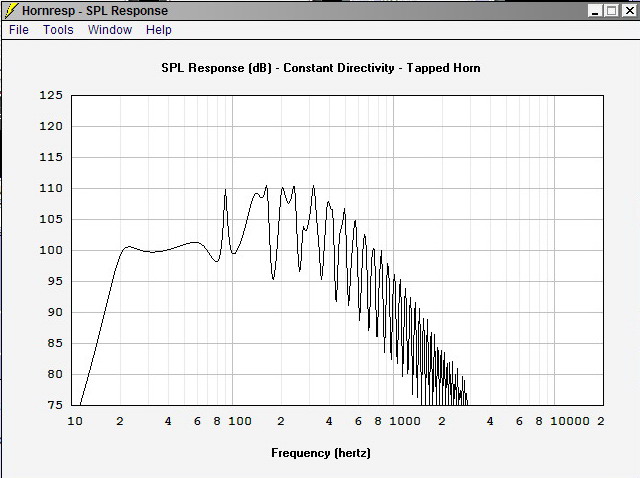
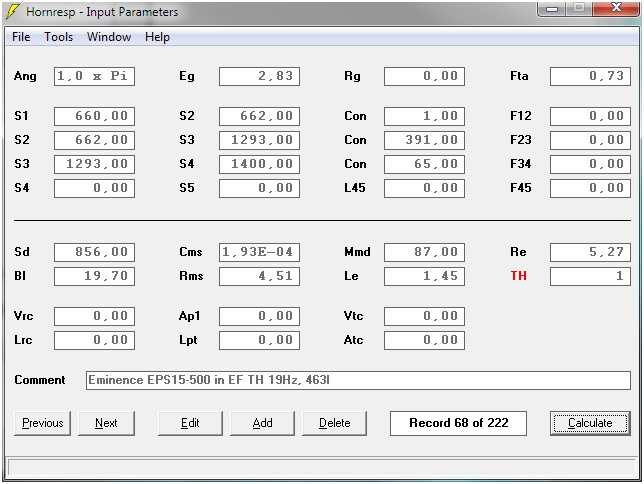
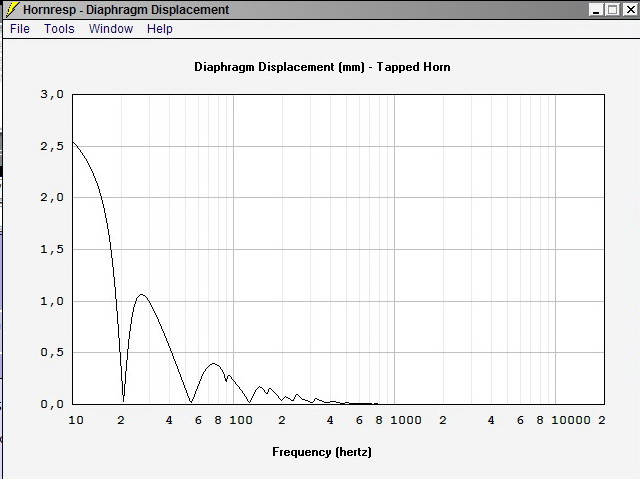
Regarding the room gain I like the idea of EQing the response down and gain some headroom.
The speaker I intend to use will reach Xmax with only a little above 15V @ 20Hz (115dB should be fine anyways).
Any comments so far? I'd like to start asap.

Due to the folding I had to reduce the overall length a little bit. With the original path length it would not vertically fit into my room.
The following parameters result fom that:



Regarding the room gain I like the idea of EQing the response down and gain some headroom.
The speaker I intend to use will reach Xmax with only a little above 15V @ 20Hz (115dB should be fine anyways).
Any comments so far? I'd like to start asap.
@AndrewT:
This is what I meant.
At approx 17V a displacement of 6mm+ will achieved, resulting in 115dB@27Hz.
This is what I meant.
At approx 17V a displacement of 6mm+ will achieved, resulting in 115dB@27Hz.
I just found out that the el-cheapo Eminence 3015LF (9,6mm Xmax, 130 Euro) as well as the Eminence 4015LF (9mm Xmax, 250 Euro) perform very similar to the obsolete Eminence EPS 15-500 in my design.
In half space with 25V at the terminals, the 3015LF will be able of almost 117dB @ 20Hz / 119dB @ 27Hz (excursion peak) in my design. Oh boy, this will rock the house.
In half space with 25V at the terminals, the 3015LF will be able of almost 117dB @ 20Hz / 119dB @ 27Hz (excursion peak) in my design. Oh boy, this will rock the house.
Tapped Horn Vibrations
When you build a sealed box, you have to be very conscious of stiffening the box because there's tremendous energy created by the backwave.
Since the back wave in a tapped horn exits the enclosure, does that mean that we can get away with lighter construction?
When you build a sealed box, you have to be very conscious of stiffening the box because there's tremendous energy created by the backwave.
Since the back wave in a tapped horn exits the enclosure, does that mean that we can get away with lighter construction?
G'day Patrick
I would argue that the pressures in a tapped horn are even higher than those in a sealed box. A tapped horn has much better cone control than a sealed box (in the pass band), and it's air pressure that is providing this cone control. I've found that significantly higher input powers are possible compared to the predictions before the driver complains, as long as input below cutoff is filtered out.
Volvotreter, you might want to look at making the mouth a bit smaller to lose some of the sensitivity down low (and make the box more manageable). I find a subwoofer response that slopes up 4 to 6dB through the passband works out pretty well in most rooms. This will let you make your box much smaller. You can get excellent performance out of a 12" driver in a smaller box, too. I built and tested a small 30Hz tapped horn on the weekend using the Peerless 830564 XLS 12" driver. Measured response is a gentle 5dB slope from 28Hz to 100Hz with a half space sensitivity of 97dB. The horn is happy with >500WRMS in the pass band. Total internal volume is only 165 liters. In room the response is flat, and capable of silly output levels.
Cheers
William Cowan
I would argue that the pressures in a tapped horn are even higher than those in a sealed box. A tapped horn has much better cone control than a sealed box (in the pass band), and it's air pressure that is providing this cone control. I've found that significantly higher input powers are possible compared to the predictions before the driver complains, as long as input below cutoff is filtered out.
Volvotreter, you might want to look at making the mouth a bit smaller to lose some of the sensitivity down low (and make the box more manageable). I find a subwoofer response that slopes up 4 to 6dB through the passband works out pretty well in most rooms. This will let you make your box much smaller. You can get excellent performance out of a 12" driver in a smaller box, too. I built and tested a small 30Hz tapped horn on the weekend using the Peerless 830564 XLS 12" driver. Measured response is a gentle 5dB slope from 28Hz to 100Hz with a half space sensitivity of 97dB. The horn is happy with >500WRMS in the pass band. Total internal volume is only 165 liters. In room the response is flat, and capable of silly output levels.
Cheers
William Cowan
- Home
- Loudspeakers
- Subwoofers
- Collaborative Tapped horn project